It's not much of a secret that us winemakers drink plenty of coffee and beer to keep ourselves awake and sane during the harvest. The other tool most often invoked to keep the body and mind moving forward is music. The cavernous nature of a winery cellar, with its mix of concrete, steel and wood makes for a uniquely rich listening environment. Full of soft reverb and warm low end. Every harvest a few songs stick out, getting repeated often enough that they become intrinsic parts of the vintage. I still can't drink any 2009 wines without hearing Basic Space on repeat in my head. So in that spirit, here were the songs that most influenced the wines of 2013.
Blue Hawaii - Try To Be
Local Natives - Heavy Feet
Phosphorescent – Song for Zula
Mount Kimbie - Made To Stray
Glass Candy - Geto Iko Iko
King Krule - Easy Easy
Cults - High Road
FKA Twigs - How's That
Cvrches - We Sink
Lucius - Until We Get there / Don't Just Sit there 2 songs back to back on album
In a previous life, music was my all encompassing passion. Although a terrible musician, I loved listening to as many different sounds as possible. I was the music director at my college radio station. I hung out at the local record store almost daily, asking the clerks for things to listen to. I was a constant volunteer to DJ parties, wedding, or any event people would let me dictate the music at. This also meant stopping at any thirft store I ever passed by, and digging trought the stacks of old vinyl. You can't listen to a record at a thrift store, so you buy things based on the design of the sleeve, the year produced, the name of the record label, or just based on knowing something about the artists. Finding a copy of Journey Through The Secret Life Of Plants by Stevie Wonder was considered a coup even though I knew nothing about the album. But a double LP soundtrack by Stevie, from 1979, for a documentary about plants, this was obviously a gold mine.
While there were some great songs on the record, it also got me interested enough to track down a VHS of the movie. (Youtube has made life much easier). This coincided with the release of the the Michael Pollan book the Botany of Desire, a book that was being passed around at the coffee shop I worked at. My eyes and mind were suddenly looking at plants in a different way. Plants were suddenly much more alive to me, I became fascinated in learning about the ways they interact with each other and the environment. I didn't know it at the time, but this little journey was another building block in creating a knowledge base for winemaking.
The idea of the importance of vintage, the year of a wine's production, is a whole hearted endorsement of the idea that plants interact with their environment in a pro-active way. It is not just a simple wet years make watery wines, dry years make concentrated wines. The vineyard reacts in much more varried ways. Experience has shown me that the wines we produce from our lands are fundamentally dictated by how the vines adapt to changes in weather for the year. And based on that experience, I could not be more excited for the 2013 vintage.
A fascinating read on the current state of plant intelligence was released last year, What A Plant Knows by Daniel Chamovitz. This inspired me to watch the 2013 vintage in the vineyard in a different way. I decided to start noting the weather more closely and watch how the vines reacted this year. The end of 2012 saw above normal rainfall, which was a perfect environment for their dormant stage. Since January though, there was very little rainfall. The ground was rather dry as the vine awoke and went through their bud break, shoot growth, and flowering stages. In reaction to this, the vines are producing very small, dense clusters. The berries I imagine are going to be smaller and have thicker skins than ususal, which will help prevent evaporative loss. These are the grapes you dream of making wine from. The increased ratio of skin to juice is what leads to the production of wine with the perfect levels of extraction and fruit. The job of the winemaker becomes when to decide enough is enough, as opposed to wishing you could get more out of the fruit.
This will probably lead to yeilds being be a bit lower this year, but quality is of the biggest concern for a small winery like Calcareous. And if things contiune as they have so far this year, the quality may be the best of I have ever experienced. This of course is all in thanks to those smart vines behind the winery figuring out how to get by in a warm, dry year.
Bonus: Spring in our step Cellar Music For 2013
The cellar can be a dark place. Lights are kept low and stacks of barrels cast all sorts of shadows to make things even darker. Basically, without a flashlight, not much can be accomplished in the cellar. So picking out a good light is not an inconsequtial task. It is also an amazing demonstration as to how the smallest design features can greatly affect daily work at a winery.
Asking an American winemaker what flashlight they use is akin to asking an Aussie winemaker what shoes they wear, there seems to be a universal answer. There are probably five or six Mini-Mags lying around any cellar I’ve ever been in. It is sturdy, bright, and the beam can be focused which is a big help when checking the level of a big tank from up top. While an iconic piece of industrial design, there are a few issues that stick in my craw about these lights. First, it takes two hands to turn on and off, two hands that many times you don’t have available. Another problem is the incandescent bulb. It sucks up battery life quickly, and it can break when dropped onto the concrete cellar floor. Lastly, everyone uses these things so they tend to get “borrowed” which leads to mornings wandering around looking for a light.
Luckily, it seems that the company has heard from people like me before, so an answer to most of my problems exists. It uses a push button on/off that can be operated with one hand, and the battery life goes from 5 hours to 200+ hours, which is nice. Bulb also seems to be a lot sturdier to the inevitable drop. Overall I tend to like this light quite a bit more than the classic and it is slowly taking over.
Another option for overall use that has unique advantages is a headlamp. The big advantage here is hands free operation. Great for barrel work like topping in place and what not. Also, there are many times I need to sample a vineyard before sunrise during harvest. The headlamp is the only way to go here. You can even harvest at night using these and tractor work like spraying needs to be done at night, so headlamps are a winemaker must in my opinion. My personal favorites are the basic models from Petzl and the Black Diamond.
The only problem I have had a hard time addressing is the “borrowing” problem. The better and more functional a light is, the greater the odds it ends up somewhere besides where you left it. Thus I was looking for a light that maybe was a bit weird or unique enough that people would avoid using it. The solution appeared recently with the invention of probably the coolest personal light ever made, the Mini Hozuki . Maybe not the most practical light, but it is just plain fun to use and cool to play with. It is bright enough that it lights up the entire interior of a tank, so it does have come practical applications. It can even hang from a barrel rack with the built in magnet. But most of all, people just won’t borrow it because they have no idea what it is. This is just one of those items that you just plain will not be disappointed in.
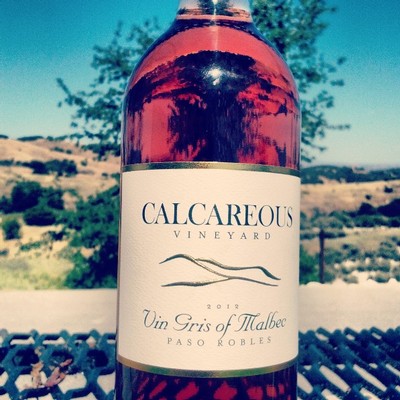
This isn’t my first rosé rodeo. In fact, the first wine to ever carry the mark of my hands was the 2007 Calcareous rosé. I was the cellar assistant back then, and the winemaker felt that experimenting with a rosé might be a good way to let me learn a few things. As many winemakers do in this area, we preformed a saignée on almost every lot of red grapes. Saignée is French for bleed, in winemaking it refers to removing a certain percentage of the juice from your red wine ferment. The primary goal is to increase the extraction concentration of your red wine by creating a greater skin to juice ratio. The juice that is bled off is just a bonus. Often it is allowed to flow down the drain, but it can be treated as a must to ferment like white wine, thus creating a rosé.
I was tasked with making a wine from this bled off juice, consisting mainly of Syrah, Zinfandel, and Grenache. I was proud of the fact that I safely guided the juice through the process and the wine was eventually bottled. It was a decent wine, but a bit off balance. This lack of balance to me was inherent in the process used. The grapes were picked under the pretense of creating dense, full bodied and powerful red wines. The fully ripe grapes did in fact do that. Our 2007 Estate Syrah and Zinfandel set a standard for the type of wines we want to create here at Calcareous. Sadly, this did not in my opinion carry over to the Rose. Without the balance provided by the tannins and other phenolics from the skins, the resulting wine tasted off kilter. The alcohol was a bit more upfront and the acid was lacking, creating a wine with little backbone and character.
Being a fan of pink wines I decided I should try again. In order to push myself to create a wine of quality, I decided I would name it after one of my personal favorites, Robert Sinskey’s Vin Gris. It also meant, taking a new approach to the winemaking process. I would use a single varietal, chosen during harvest from the lot I felt showed the best characteristics for the task at hand. As should have been expected, 2009 was an extremely hot and dry vintage, thus all of the picks came in way too ripe for using in a rosé and I had abandoned hope of making a rosé. Then, right at the end of harvest, along came a freak storm that dropped over 7 inches of rain during a 30 hour period. The only thing left on the vine at the time was the Estate Mourvedre. To prevent any mold or mildew, the grapes were picked right after the storm. During processing, I saw that the sugar level had dropped from 24% to 22%, an obvious sign of rain induced dilution. The lot was going to require a saignée in order to create a Mourvedre of decent concentration. The resulting Estate Mourvedre was perfect for blending with some very ripe Grenache harvested earlier during the vintage, and our elegant 2009 Grenache Mourvedre was born. It was a happy accident, one of those wines that is not planned but creates itself during harvest if you keep an open mind and avoid dogmatic approaches and goals. The juice that was bled off was light and lively, it created a wonderful wine in its own right. It had low alcohol and decent acidity, making for a pleasurable wine. The dilute nature of the wine though showed in a slight lack of fruit and body. Trying to make up for this, I discovered a useful cellar technique. I collected the lees from the finished Mourvedre ferment, and added it to the rosé. This greatly increased both the color and body, and added a bit of real character and distinction to the palate. Again, this was a happy accident and as good an argument as any for making rose. It is liberating to work with juice that otherwise would end up down the drain. You are free to take risks and try new ideas that come to you as there is very little to lose.
Over the next couple of vintages, none of the lots that came in featured any juice I felt would be suitable for making a rosé. So for 2012, I decided it was time to create a specific rosé lot. Most of the blocks of our Estate Calcareous Vineyard naturally produce about 2 tons to the acre. That is, except for the Malbec. Maybe because it is our only truly flat block, but for whatever reason, we have to drop a considerable amount of Malbec on the ground in order to get things properly ripe. Last year I had the vineyard crew leave 12 rows of the Malbec block untouched when they did their fruit thinning. This was to be my “Rosé Block”. The fruit was tasted with the sole intention of creating a rosé, thus I tasted the fruit in the same way I do when sampling Chardonnay or Viognier. Primarily interested in sweetness, acidity, fruit, and the feeling of the pulp, I could ignore the skin because it was not going to be used.
Being a small lot and still early in harvest, the cellar crew and I hand-picked the grapes ourselves. The grapes went straight to press and treated almost exactly how we process and ferment our Rhone whites, except of course for the addition of Malbec lees during winter. The resulting wine is what I feel is an honest Rosé, created for its own sake. I also think it is hands down the best rosé we have created here. It has been in bottle for a little bit now and will be shipping out for our summer wine club. I hope you enjoy the fruition of what has been a 5 year process. Ending with the discovery of how to craft a pink wine that is worthy of the Calcareous label.
When McLuhan saw the typo he exclaimed, ‘Leave it alone! It’s great’ Thus there are now four possible readings for the last word of the title, all of them accurate: Message, Mess Age, Massage, and Mass Age.
One of the aspects of the “information age” that I find troubling is the fixation on the media and not the information. Everyone seems to be pre-occupied by how something is said instead of what is said. More effort is used up deciding whether to use email, text, blog, twitter, facebook, pintrest, tumblr, google+, wuphf… then is used in thinking about what is to be said. The world seems more concerned with the quality of the devices used for retrieval and display, and less about the creating content of actual quality or use. The end product of this type of thinking is the creation of a veritable cacophony of insipid information. I find many similarities to this when getting involved in the discussion of wine. Too often the conversation is limited to the media, in this case wine, and the content goes missing.
Franz Lebowitz famously said “Great people talk about ideas, average people talk about things, and small people talk about wine.” Whereas most people that align themselves professionally with wine simply bristle at this notion, I whole heartedly agree. I can’t think of a worse group of dinner companions then a group omphaloskeptic wine experts humming a mantra of aromatics and phenolics to each other all night. I like to think of wine as a portal to almost any topic one finds fascinating. The more one learns about wine, the more one is exposed to the fundamental ideas behind it.
Whenever I give a cellar tour, host a tasting, or walk guest through the vineyard, my singular goal is to take the questions given to me and answer by thinking about bigger concepts. In this way, we can move beyond the superficial and towards the profound. Luckily, I have found that most questions people have about wine are quite easily shifted in a more interesting directions. This in turn creates a deeper understanding of the topic and of one’s own beliefs and opinions.
For example, when asked about using French, Hungarian, or American barrels, the conversation can take all sorts of turns. What is an oak tree’s perspective on human created geopolitical borders? How old world and new world forest management techniques describe the different views each have on the abundance of natural resources. Or perhaps, the evolution of American cooperage technique which was initially based on storing sea faring and colonial salt pork, moved on to whiskey storage, and only recently embraced the unique needs of wine ageing.
The discussion of wine tasting and reviewing easily lends itself to thinking about the nature of perception and individuality. Wine’s intrinsic role in commensality is the perfect stepping off point for demonstrating the unique way each of us experiences the shared moment. The list of possible topics that can begin with wine is nearly endless. Arguing the merits of modern, organic, or biodynamic farming techniques is tantamount to thinking about how best to be sheppards of this planet. When we talk of the relative importance of the vineyard and the vintner in the creation of a bottle of wine, we are really feeling out our thoughts on nature vs. nurture. This is why there is so much written about wine, why wine blogs like this one seem to be in every corner of the internet. Wine is truly intertwined with the human condition.
Of course, drinking a glass of wine with friends does not require that a class of Philosophy 101 begin each night. Most commonly, wine is just the first spark of a long night spent talking about family, friendship, food, travel, culture, the arts; the topics that make life so enjoyable. So please, do take the time to learn as much as you can about wine. Not so you can be an expert on wine, but because it can lead you to wherever your true fascinations lie.
Winemaking can really be tough on clothes, especially pants, so finding good work clothes has been more of a challenge than I ever expected. The mix of vineyard and cellar work, hot dry conditions followed by wet and cold on a never ending cycle really tests garment quality. My first few months working I just assumed that a pair of random denim jeans is all I’d ever need. I learned quickly that cheap blue jeans, those on the Ross clearance rack, are not really up to the task. Blown out seams and fabric rips give them a working life of maybe a month or so. By my second harvest I had moved on to the ranch classics, Levis 501s and Wrangler 13 WMZs. While these were a definite step in the right direction, they still only gave me a shelf life of a couple months before some type of integrity fail reared its ugly head.
I eventually decided to trial some of the tougher work wear classics like Dickies, Carhartt and Ben Davis. The Dickies performed much like the hardier jeans, falling apart after a promising start. During testing, the Ben Davis held up great, lasting a whole harvest of wearing 4-5 times a week. But the fit wasn’t the most comfortable. They are a bit baggy which can lead to snagging on things like drip lines, barrel racks, and tank valves, no good! Carhartt became my go to work pants during the 2009-2011 harvests. Overall, they gave the best performance and comfort at work. Plus Carhartt was based in my hometown of Detroit, well Dearborn is kind of Detroit. I thought I'd never have to think about work pants again.
Sadly, something changed. The Made in USA tag on Carhartts disappeared and was replaced with Made in China or Mexico. Call me crazy, but the crotch seams started failing after a few months. I started to get fabric tears and the fit was not what it used to be. Then I started to notice that not a single pair of work pants I had been trying were made in America. This got me thinking, does anyone make sturdy work clothes in this country anymore? A little research led me to discovering probably the world’s best pair pants. The Filson Oil Finish Double Tin Pants have no equal. When the first 2 customer reviews I read were 5 stars from a logger talking about the pants handling a whip from a broken chain saw and a Canadian Railway engineer who’s had a single pair for 8 years, I knew I had moved in the right direction. They are not as cheap as other pants I'd tried, but not crazy expensive for quality clothing. I mean, they are cheaper than most women's denim pants these days! Plus, I don’t think it is physically possible to damage these things. Everyone should own a pair of Double Tine Cloth pants, just to feel the sensation of what a truly well crafted piece of work clothing feels like. It was like the time I was shopping for my wedding suit and my friend took me to a shop in San Francisco that only sold hand-made Italians. Everything else just plain feels wrong and cheap once you wear the real deal.
The only problem with the Big Boy Filson’s is that they are a bit too heavy duty. In August, when it’s 112 degrees in the vineyard, they can get a bit sweaty walking around. Plus, the oil finish has a strict no washing allowed rule. Things can get a bit funky! So in searching for something a bit more daily practical, I came across my current favorite work pants, Earl’s Gung Ho Camp Trouser. These are darn near a perfect pair of work pants. Sturdy 12oz duck cloth, button fly, a unique cut, made in Texas, affordable…etc. I think, after all these years, I’ve found my daily work pants. Sadly there are rumors that Earl's may be going out of business, so stock up while you can. But of course, the experiment never ends. I have pair of these coming in for testing during this year’s harvest. And I’m always open to suggestions, so if you have a pair of pants you think can handle the work, I’m all ears.
A good friend of mine, who is a winemaker, overheard an interesting comment the other day. It was from a beer drinker who stated, "I just had a bottle of (unnamed rather famous IPA) and it had this weird band-aid smell and taste" Alarm bells went off in my friend's head. When he passed on that little bit of info to me, I had the same felling of panic. It was "Oh no, all of my favorite micro-brews are about to all start smelling and tasting of Brett!"
In cases you haven't noticed, a big trend in beer brewing over the past few years has been the surge in beers brewed with Brettanomyces. Brett, as it is called for short, is a "wild" yeast that produces a very distinct olfactory and flavor profile in the beverages produced using it. The most common description of this profile in wine is either "band-aidy" as in the smell of a box of band-aids, or "barnyard" as in hay soaked in the waste of farm animal. Not exactly the most endearing of descriptors.
Along with ripeness (although this is getting smaller with every passing vintage), probably the biggest differentiator between "Old-World" and "New-World" style wines is the presence of Brett. Taste most really cheap imported European wines, and you will get a heavy dose of Brett. One of the big problems with Brett, is once it shows up, it is pretty much impossible to get rid of. Even with all our sanitation gear like ozone generators, steam generators, UV barrel lights, gaseous sulfur dioxide, if a hint of Brett shows up, there's not much to do. Here at Calcareous, if I smell or taste it in a barrel, the wine is destroyed far away from the winery and the barrel goes straight to the BBQ wood pile. All the sanitation work is the lock on the door, once the intruder get's in; the only option is to blow the place up.
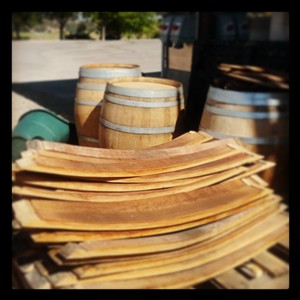
Brett Wood: Coming to a Tri-Tip near you!
Why such drastic measures? It goes back to one of the classic "throw-away" winemaker interview terms that actually does mean something to me. I truly want to "respect the fruit". I want the wine produced at Calcareous to taste of our vineyard. The problem with Brett is that everything it touches taste like, well, Brett. The fruit and the vineyard definitely take a back seat to the yeast in its case. The reason I like to use commercially available yeasts is that it allows me to choose yeasts that have as neutral an effect as possible on the wine. I pick our grapes during harvest almost exclusively on the flavor profile I get when tasting grapes in the vineyard. I remember what the fresh must tasted like when the grapes are put into the fermentation tank. Once primary fermentation is complete, I want as many of those same flavors to be present as possible. Sure the sweetness has been fermented out, but I aim for that same beautiful strawberry hint I get from Pinot Noir grape to be there in the bottle. This is why I consider keeping Brett out of the winery probably one of my single most important duties as winemaker.
So in the back of my mind as I've been tasting these Brett beers the past few years (most of which I just dump out because my winemaker brain has made me so ruthlessly prejudiced against the flavor) I've been thinking that this is a dangerous game just inviting this beast in the front door. Sure there are schools of thought that small hints of Brett can add complexity. Concerning beer, where for the most part people are not growing or malting their own barley or hops, I can see the appeal of trying to play with the flavors that different yeasts can add. But with wine, we emphasize the place, the work we do on the land should outweigh the work we do in the cellar. The flavors produced by Brettanomyces are just too dominant in my opinion. If there was a way to ensure that it played nice with everyone else, Brett could be a fun thing to play around with in a limited sense. But it tends to be a real bully when it comes to aromatics and palate, pushing everyone else to the background. I only hope that the brew masters of my favorite breweries have somehow learned to tame this dangerous beast and keep it from getting into places it is not supposed to be. If not, harvest season is going to be a much sadder place if all my favorite beers start to taste of my worst enemy.
And for a bonus here is a gif I can't stop looking at. Yu Darvish throwing 5 different pitches from the exact same motion. Makes Albert Pujols look like me at city league softball which is nice.

They enter the new world naked, cold, uncertain of all save that they enter. All about them the cold, familiar wind- William Carlos Williams
The daylight has now overtaken the darkness. Each rotation here in the North now sees more of the sun with the moon more often framed by blue than black. This is usually the time we start to look for the first signs of new life among the vines. Surprisingly, things have happened a bit earlier than usual this year. More often than not, early April gives us our first hints of green emerging from the cordon. The 2013 vintage has decided to begin just as the sun and the equator align themselves on the same plane.
In 2012, the first bud break of the Estate Chardonnay plantings took place around April 5th. Here is a photo of that same Chardonnay this last Friday, March 15.
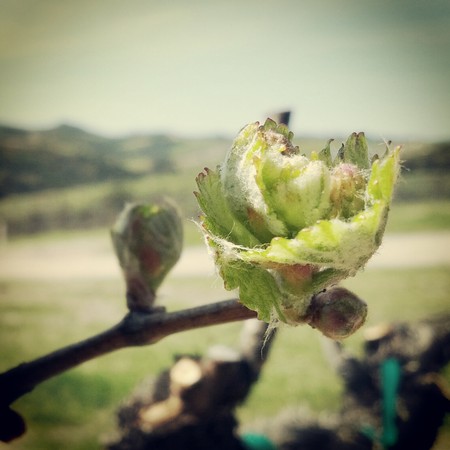
Our Estate Chardonnay was harvested on August 31st last year. This represented a journey of 148 days from bud break to the press. A similar lifespan would put the first pick of 2013 sometime around August 10th. While I don't see that happening, our earliest ever harvest was August 15th. So it is within the realm of possibility.
This has been a fairly dry year so far with no major winter storms, just the occasional light rain. The temperatures have been mild to cool, so things may slow down a bit over the next 4-5 months. There is no telling what April (The one month a year when the Central Coast Weather reporter actually must do some work) will bring. But shockingly enough, even the Malbec looks like this today.
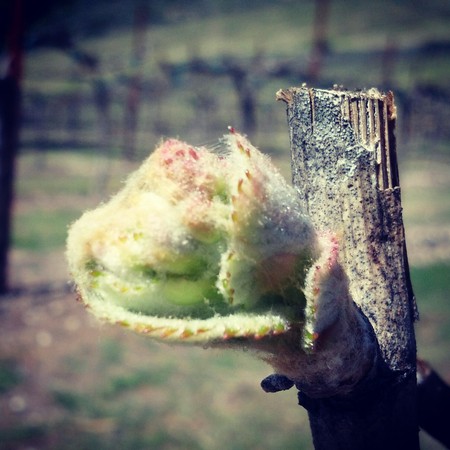
A quick walk down to the next block also saw the Syrah starting to rustle and swell. Of course, the late bloomers like Cabernet, Mourvedre and Zinfandel are yet to say their piece. The all important flowering is still yet to come. But as things stand right now, an early harvest may be bearing down on us. It is time for winemakers as well to roust from winter's time of recovery, and make the preparations for what lies ahead.
They enter the new world naked, cold, uncertain of all save that they enter. All about them the cold, familiar wind- - See more at: http://www.poets.org/viewmedia.php/prmMID/15536#sthash.2DKOMCf
If you have visited Paso Robles in the past 5 years, you probably at some point have crossed paths with Tacos Al Pastor. Be it at a restaurant, the rehearsal dinner of a friend's wedding, the club pick-up party of one of your favorite wineries, they seem to be everywhere. My first experience with them locally was at the now defunct Restaurant Tenexepa off Creston Road during the 2007 harvest. After a 14 hour cellar shift, nothing could compete with a plate full of these $1.50 pork tacos washed down with ample Negra Modelo.
Having moved here from San Francisco, I was more accustomed to the overstuffed Mission style burrito, but I quickly fell in love with these simple tacos. The perfect mix of spice and fat in the pork is matched with ample fresh onions and cilantro, then comes that special touch, the amazing addition of big slice of grilled onion and pineapple.
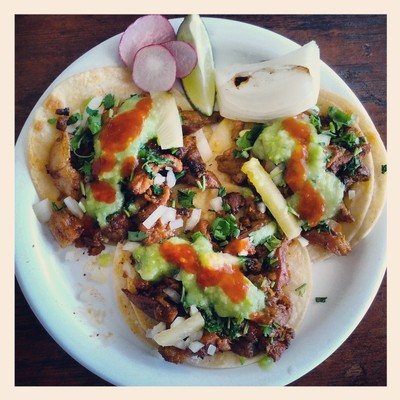
At Tenexepa, the kitchen was hidden from view, so I was ignorant of the true magic behind this now staple of mexican street food. I was also constantly told, "Just you wait, the King of Paso Robles Al Pastor is remodeling and when they reopen, you'll taste the real deal." Well, the King did reopen and I have found myself taking almost all first time visiting friends or family to the patio of Los Robles Cafe near downtown. There, for all to see is the cooking technique that sets Al Pastor apart in the cannon of Mexican cuisine. The pork for Tacos Al Pastor is slow cooked on a vertical spit.
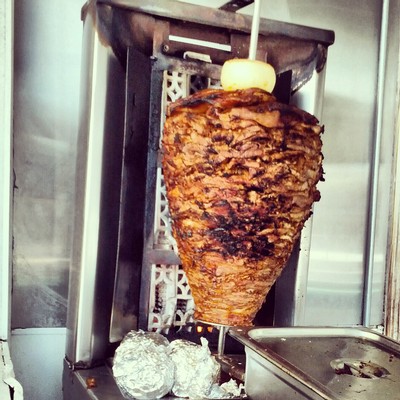
The first thought I had was, "These guys must have a friend who owns a Greek or Middle Eastern restaurant and figured he could cook pork the same way." Well, the actual story is more beautiful than that. And it speaks to how the strange search for authenticity in cuisine is a fleeting dream. Food is merely a reflection of the ever changing evolution of culture. The roots of this now ubiquitous food trace back, amazingly enough, to the collapse of the Ottoman Empire. In the time surrounding WWI, large numbers of Lebanese and Syrian Christians immigrated to Mexico, mainly to the areas around Puebla and Mexico City. They brought with them the Doner Kebab style of cooking. Over time, the locals incorporated these spits for roasting pork instead of lamb and a new food was born.
I was reminded of all this just last week as a new institution has just moved into Paso Robles. During my college days just 30 miles south in San Luis Obispo, one of my standard lunch spots was Jaffa Cafe for their famous shawarmas.

Well, Jaffa Cafe has finally opened a branch here in Paso just a couple blocks from Los Robles, and it is a must visit for lunch or dinner the next time you are in town. Plus you can enjoy this great living example of how food, culture, and history all intertwine to make this world a much more interesting place to eat, drink and live.
Where To Go:
Los Robles Cafe: 1420 Spring Street, Paso Robles
La Reyna Markey Y Carniceria: 532 24th Street, Paso Robles
Jaffa Cafe: 1344 Park Street, Paso Robles (Shared with Panolivo)
It looks like the new year is upon us. Besides the difficulty of remembering to end written dates with /13, I got to thinking about what the future holds for us winemakers. I spent the majority of my December online time looking at various "best of" lists for 2012, thinking about what has happened. This gave me the desire to put my thoughts on the future in writing, see if what I think is the future will come to pass.
One of the culinary movements that really took full hold this year was nose to tail cooking. That is, not thinking of anything as waste but using everything you get in the kitchen as a possible ingredient. This probably began as a simple reaction to economics, tougher times usually leads people to think about how to stretch things out a bit more. Then it seemed like every restaurant I went to was using things in entrees and appetizers that only a couple of years prior were solely available at various street taco vendors on Mission and 23rd.
I'm seeing something similar happening in wine as well. Here in Paso Robles, making Pink wines from bled off red juice that would normally go down the drain is now common place. Most producers have used the trick of shoveling in your pressed off Viognier skins into Syrah ferments. Now that is expanding out as more white skins are ending up in all sorts of different red ferments. You are also seeing much more whole cluster fermentations these days. That involves using the stem, which usually goes straight to compost, along with the fruit in order to add tannins and spice to your wines. It also changes your fermentation dynamics, but that's another post for another day. Grapes that have shriveled on the vine to become raisons are easily sorted out by using shaking tables and tossed onto the compost pile as well. Not anymore, they are ending up in all sorts of places now. From straight "late harvest" dessert wines to being used almost like a spice added to ferments to add hints of rich sun ripened flavors to Zins and Syrahs. These are all part of the unending experiment that is wine making.
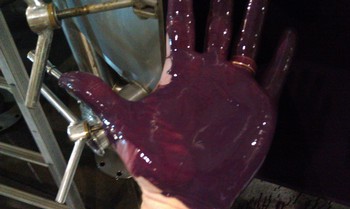
During this upcoming 2013, the waste product I plan to be trialing around with is lees. Lees is the heavy clay like sediment that settles out of wine over time. Traditionally, wine is continually racked off the lees. That is, over time, the wine is pumped off the top of the bottom sediment layer which aids in clarification and avoids strange flavors that may develop. Well, I for one am not afraid to embrace strange flavors. At a much larger winery, that could be dangerous, but that is the beauty and freedom of making wine at a smaller winery. If an experiment fails, the business does not fail along with it. By virtue of small size, we can afford to try different ideas and techniques.
Incorporating the unique flavor profiles developed in the lees is almost universal in Chardonnay production. The weekly stirring of barrel fermented chards to mix the lees back into solution is a key element in adding body, richness, and a little funk for a more complex white. I'm predicting that this the year that "sur lie" aging makes the crossover to reds.